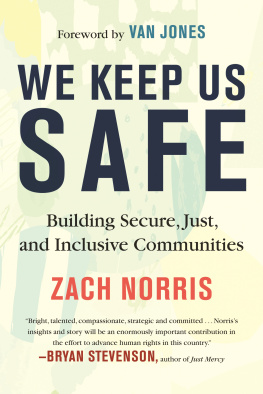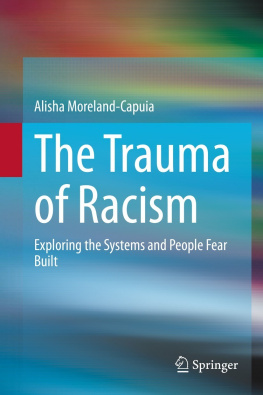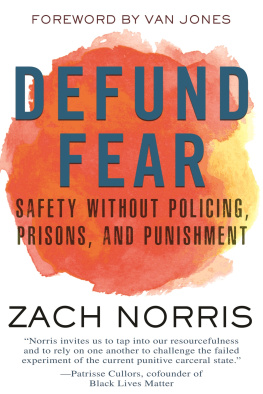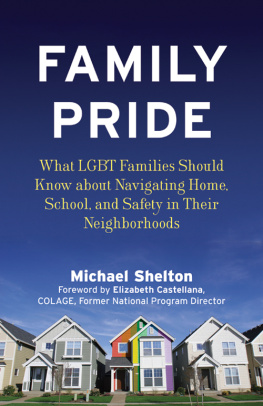Contents
Guide

FOREWORD
This right here. This book.
What Zach Norris has done in his thoughtful and ambitious book is expand the story of justice further. He reaches back in time to the founding of our nationhow did we get here?and he reaches forward, envisioning a compassionate future that promises much greater safety, particularly for all those who are most vulnerable in todays world.
The opposite of criminalization is humanization, treating each other like human beings, reclaiming the empathy and grace that seem to have fallen out of fashion.
Zachs own humanity has always been striking. He was just an intern when he came on board at the Ella Baker Center for Human Rights (an organization I cofounded in 1996): an intense young man who arrived at the office before everyone else each morning and stayed late most every night. I was reminded of a passage in Letters from Prison by the theologian and anti-Nazi dissident Dietrich Bonhoeffer:
What we shall need is not geniuses, or cynics, or misanthropes, or clever tacticians, but plain, honest, and straightforward men. Will our inward power of resistance be strong enough, and our honesty with ourselves remorseless enough, for us to find our way back?
I came to find out that the real magic happened every time Zach would interact with the families of kids who were locked up. Zachs superpower is making people feel heard. Folks instinctively know they can trust him and rely on him. Around the Ella Baker Center, we all knew Zach was the secret to the success of our Books Not Bars campaign, which helped to shut down multiple youth prisons and kept a youth super jail from being built.
When Zach took on the executive directorship of the Ella Baker Center in 2013, it was clear that the country had reached an inflection point where liberals and conservatives were agreeing that prisons were a waste: a waste of money and a waste of lives. Zach had a vision for the opposite of the endless cycles of dehumanization, deprivation, and damage. He envisioned the hope and love of the Oakland community embodied in a building called Restore Oakland. He wanted to build a kind of monument to redemption.
As this book goes to press, his vision has been realized: Restore Oakland (a collaboration of multiple organizations) has opened its doors, offering conflict resolution through restorative justice, housing and tenant rights advocacy, and a hub to organize immigrants, formerly incarcerated people, students, LGBTQ people, and other community members. Making that vision a reality was no small feat, more proof of the powerhouse we have in Zach Norris. Youd be wise to take the model of safety presented in this book seriously as well. These are common-sense ideas whose time should have come long ago.
For twenty-five years Ive been on the front lines of criminal justice reform. As an advocate, Ive been in and out of more prisons than I care to count. Ive attended too many funerals where the young people are in the caskets and the old folks are mourning in the pews.
Ive seen firsthand the devastating impact that excessive incarceration has had on generations of families and entire communitiescommunities that were criminalized, that came to be regarded as dangerous and suspect. And Ive seen the suffering of the survivors and the families who have been hurt, who rarely if ever have found healingeven when those who hurt them spend their life behind bars.
Americas criminal justice system is based on retribution, the primitive notion of an eye for an eye that Gandhi says leaves the whole world blind. The damage done by an incident of violent crime is often horrific enough. But then society adds more damage with a system hell-bent on revenge. How is damage plus damage supposed to add up to justice and healing? Thats an equation thats never going to work.
It is sometimes justified or necessary to place a human being behind bars. But incarceration is hardly the panaceafor the wrong-doer, for the victim, or even for societythat the public is led to believe it is. In fact we are far more likely to get to accountability and healing if we acknowledge each others humanity and engage with each othereven when that is the very last thing we feel like doing.
My documentary series on CNN, The Redemption Project, is based on the understanding that the verdict in the courtroom is never the end of the story. The verdict may be the end in a bunch of TV shows featuring smart prosecutors, but not in real life. The real story keeps unfolding for years, often decades, after that momentand it doesnt usually have a happy ending.
On December 21, 2018, US president Donald Trump signed the First Step Act into law. The landmark bipartisan law allows thousands of people to earn an earlier release from prison and will cut many more prison sentences in the future. My team at #Cut50, a campaign I cofounded to change laws and policies to halve the number of people behind bars, was part of the unlikely coalition that got it done. We mobilized formerly incarcerated people, celebrities, grassroots and business leaders, and, yes, Republican allies. I called its passing a Christmas Miracle. Yet, of course, it was called the First Step for a reason. There is so much more to do. In housing, in schooling, in bringing people from the margins into community.
Putting into place the model of safety described in this book might just be the Last Step.
Van Jones
INTRODUCTION

US VS. THEM
June 2014
My family was out of town visiting relatives when someone broke into our house. I had received a call from our alarm company, but wed had false alarms so often, like the Boy Who Cried Wolf, that I no longer knew whether to believe it or not. This time, however, it was for real.
We came home to find a window smashed, broken glass everywhere. It wasnt just any window in the house, either, but the window in the room shared by my two small daughters, who were two and four years old at the time. And it wasnt just any window in their room: it was the one right above the girls bed. Glass had shattered all over the spot where my tiny, amazing, and precious daughters sleep at night. There might be worse nightmares for a parent, but this was up there.
What if we had been home?
Isnt that the horrifying thought that every parent has in this situation? It certainly was mine, and it got stuck on repeat as I set about cleaning up the mess. I collected the shards in a doubled-up paper bag. I had to be careful not to cut myself. The glass was jagged and sharp everywhere. One of the pieces was larger than my hand, and heavy, easily big enough to cause permanent if not fatal damage. It made a clanking sound when I dropped it in the bag with the rest. I picked up the next piece off my daughters pillow.
It took me back to one of the first moments I ever held my older daughter. She was born one day shy of being premature and weighed less than six pounds. Her skin bunched up at the knees and elbows as if to say, I wasnt ready to come out! Im still growing! My wife had just gone through a thirty-nine-hour labor and was sleeping, deservedly so, while I held the tiny baby girl, in awe and in tears.
So much could have gone wrong. The United States has the worst rate of deaths from childbirth- and pregnancy-related complications in the developed world, and (across all levels of wealth and education) women of colorlike my wifeare several times more likely to die than white women, due to racial and cultural bias in healthcare.












